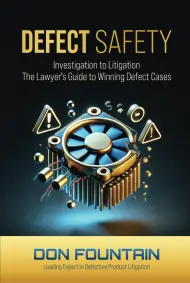The Week In Torts – Cases from March 7, 2025

Now you see it, now you don’t
FLORIDA LAW WEEKLY
VOLUME 50, NUMBER 9
CASES FROM THE WEEK OF MARCH 7, 2025
COURT REVERSES SUMMARY JUDGMENT IN SLIP AND FALL CASE BASED ON OPEN AND OBVIOUS DANGER — FACTUAL QUESTIONS OF DANGEROUSNESS AND FORESEEABILITY EXISTED
Ortega v. JW Marriott Investment LLC, 50 Fla. L Weekly D511 (Fla. 3rd DCA Feb. 26, 2025):
The plaintiff tripped and fell on a raised and unmarked concrete slab designed to anchor a vehicle gate arm in a parking garage at the Turnberry resort in Miami. The plaintiff alleged she was returning to her vehicle when she tripped and fell on an elevated section of the concrete that was in her path.
The defendant moved for summary judgment arguing that the plaintiff’s own admissions as well as the photographs of the area showed that the gate arm concrete slab was “open and obvious,” and there was no evidence of any negligence on defendant’s part. Defendant also relied on the plaintiff’s deposition testimony, where she testified that she had worked at the resort for the last six years, and had long parked in the same garage where the incident took place.
On the morning of the incident, she was not working but had parked in the garage to meet a friend for a walk around the golf course path. She parked in a space that she often parked in.
The plaintiff admitted she had previously seen the concrete gate arm slab on other occasions and had not tripped on it because she saw it. She acknowledged in her deposition that she misjudged the height of it. The plaintiff also acknowledged there were other ways for her to get to her vehicle but testified that she took a route because it was the most direct.
The plaintiff submitted an affidavit, as well as the affidavit of her expert engineer, and photographs. The engineer testified that there was a lack of a painted edge and no alternative pathway to accommodate pedestrians, and that, combined with the known human factors of pedestrian behavior, made it difficult for her to perceive the concrete gate arm slab.
The expert opined that the slab was not readily distinguishable to a normally attentive pedestrian. He also opined that the platform’s condition violated industry standards for safe walking and that the subject walkway was in a substandard condition, and unreasonably dangerous for people accessing the area. The expert concluded that the combination of those conditions was likely the direct cause of the incident.
The plaintiff’s affidavit dated after her deposition stated that she had tripped over the elevated section of the concrete because she was not able to see it. She further attested she did not regularly take the direct path that she took on the day of the incident and said that defense counsel had misstated her prior testimony and that she consistently and clearly stated she was able to avoid tripping on the elevated section of the concrete on prior occasions because she was able to see it.
The court reversed the summary judgment.
Landowners owe invitees two duties: (1) the duty to use reasonable care in maintaining the property in a reasonably safe condition, and (2) the duty to warn of latent or concealed dangers which are or should be known by the owner and unknown to the invitee and can’t be discovered through the exercise of due care.
While some conditions are obvious and not inherently dangerous and not constituting of a dangerous condition, they can still give rise to liability. Even if a dangerous condition is open and obvious, landowners may still have a duty of care where some uncommon design or aspect of the condition creates a hidden danger or a trap or an optical illusion not reasonably discoverable by an ordinarily prudent invitee.
On this record, the court found a material issue of fact existed as to whether the concrete gate arm slab was open and obvious and whether the defendant violated its duty to maintain the premises in a reasonably safe condition. Thus, the entry of summary judgment was improper.
ERROR TO DISMISS A COMPLAINT WITH PREJUDICE FOR FRAUD ON THE COURT — EVIDENCE DID NOT DEMONSTRATE THAT PLAINTIFF HAD SENTIENTLY SET IN MOTION A SCHEME TO DEFRAUD THE COURT
Swenson v. Walmart Stores, 50 Fla. L. Weekly D494 (Fla. 1st DCA Feb. 26, 2025):
A woman sued Walmart for food poisoning, that she alleged resulted from Walmart’s failure to properly inspect or prepare its chicken. The food poisoning required extensive treatment including surgery.
The plaintiff had denied any history of gynecological issues before the incident and denied being treated by a doctor or hospital in the “same areas of the body” before her incident in response to the defendant’s interrogatories. However, she did note that she had suffered from a left ovary problem at the time of the incident and also disclosed multiple prior treating physicians with whom she had treated prior to the incident.
At the hearing on Walmart’s motion to dismiss for fraud, the plaintiff testified she did not believe she had prior treatment to the same areas of the body injured by the food poisoning incident. She advised she was treated “for areas below the stomach.” Her counsel argued that the plaintiff’s claim of food poisoning involved complicated systems that would go on inside the body, rather than something that could be definitively pointed out and, for example, a leg injury.
Because the court found there was a possibility of confusion regarding the questions being asked and the body systems involved, and because the plaintiff had provided Walmart with full access to her prior medical treatment, it found the case lacked the required explicitness and evidence of intent.
Since the court could not legally conclude that the plaintiff had clearly and convincingly sentiently set in motion some unconscionable scheme calculated to interfere with the judicial system’s ability impartially to adjudicate the case, it ruled that the trial court erred in dismissing.
The appellate court went on to say that even if it had found competent substantial evidence to support the trial court’s finding of fraud, dismissal was still not appropriate to bar a party from its day in court, which could run afoul of the party’s constitutional right of access to courts under the Florida Constitution, except in the most extreme cases where it appears that the process of trial has been subverted.
TRIAL COURT ERRED IN DENYING THE NONRESIDENT DEFENDANT’S MOTION TO DISMISS FOR LACK OF PERSONAL JURISDICTION – THE COMPLAINT DID NOT SUFFICIENTLY ALLEGE THAT THE DEFENDANTS COMMITTED A TORTIOUS ACT WITHIN THE STATE WHERE THE ACCIDENT OCCURRED, NOR DID IT SUFFICIENTLY ALLEGE THE DEFENDANTS WERE ENGAGED IN SERVICE ACTIVITIES WITHIN THE STATE AT THE TIME OF THE INJURY
Kendricks v. Culp, 50 Fla. L. Weekly D497 (Fla. 1st DCA Feb. 26, 2025):
The defendant and the decedent were involved in a trucking accident that resulted in the decedent’s death. The accident occurred in Georgia, 10 miles north of the Florida Georgia border, when the defendant and the decedent were traveling to Florida to make deliveries in the state.
The defendant driver was driving a truck for a company that had been hired by the co-defendant to transport a load of pool supplies and chemicals from Georgia to Fort Walton Beach, Florida. While the decedent was a Florida resident, the defendant driver was a Georgia resident. The defendant company was a Missouri corporation, and the other a Kansas corporation.
Following a non-evidentiary hearing, the trial court denied the defendant’s motions to dismiss for lack of personal jurisdiction, finding that the complaint sufficiently alleged specific personal jurisdiction under the long arm statute, Section 48.193(1)(a).
However, the appellate court reversed. It found the amended complaint did not sufficiently allege that at the time of the injury, the defendants were engaged in service activities within Florida under Section 48.193(1)(a)6a. Although they were only 10 miles away, the defendants were not yet providing services within Florida at the time of the accident.
The court also found that the amended complaint did not sufficiently allege that the defendant company’s tortious act “arose from and related to” its business activities in Florida under Section 48.193(1)(a)1. Although the defendant had business activities in Florida, none of the acts related to the claims against it occurred in Florida.
Because the allegations had failed to meet the long arm statute, the court reversed with directions for the trial court to dismiss the complaint against these defendants.
ANOTHER CASE WHERE THE APPELLATE COURT REVERSES A TRIAL COURT’S DETERMINATION THAT PLAINTIFF MET THE BURDEN OF STATING A CLAIM FOR PUNITIVE DAMAGES
Tesla Inc. v. Banner, 50 Fla. L Weekly D529 (Fla. 4th DCA Feb. 26, 2025):
The plaintiff was driving a Tesla when he was hit by a tractor-trailer that ran a stop sign. The Tesla drove under the trailer, shearing off the top of the decedent’s vehicle, killing him instantly.
A crash investigation revealed that 10 seconds before the collision, the decedent activated two of the vehicle’s enhanced autopilot features. He set the traffic aware cruise control and adaptive cruise control technology at 69 MPH and engaged the vehicle’s auto steer feature.
The decedent’s estate sued Tesla for strict liability and negligence in connection with the enhanced autopilot features. The estate claimed that despite Tesla’s claim that it had full self-driving capabilities, the vehicle lacked a sufficient crash avoidance system and made it unsafe for its intended and foreseeable use.
The estate alleged that the vehicle lacked a safe and effective automatic emergency braking safety feature and further alleged that Tesla specifically knew that its product would not be properly and safely able to avoid collisions with other vehicles and obstacles in its path but failed to make appropriate changes to fix the defect. The complaint alleged that the decedent was unaware of that defect, which was not apparent by a reasonable inspection.
For the plaintiff’s proffer, he attached the inadequate testing, design, and manufacture of autopilot, government investigations, and recommendations from NHTSA, and numerous prior incidents showing that the product had completely failed causing catastrophic damage.
The motion stated that despite Tesla’s knowledge, it failed to correct its defective product, instead issuing public statements that continue to mislead the public about the capabilities and safety.
In response, Tesla asserted that the decedent worked as a computer software engineer and was tech savvy and intelligent and was known as a computer and car geek. With his background in mind, Tesla noted that the decedent purchased the enhanced autopilot but declined to purchase the full self-driving capability option which promised customers the ability to use full self-driving when the feature became available. It also pointed to the owner’s manual providing numerous directions and warnings concerning the system and its limitations.
Ultimately, yet again, the appellate court reversed a trial court that allowed an amendment for punitive damages. It concluded that the record did not support a finding that Tesla knew or should have known that the driving assistant features were likely to cause death or great bodily injury.
Instead, it wrote that the evidence indicated that Tesla’s autopilot features were state of the art and complied with all industry and regulatory standards. Additionally, Tesla repeatedly warned against misuse of the features which was industry practice.
While the estate’s expert testified that Tesla was liable for gross negligence and intentional misconduct in 20 different ways, the court concluded that Tesla could not be liable for failing to provide technology that it did not advertise and that did not exist.

